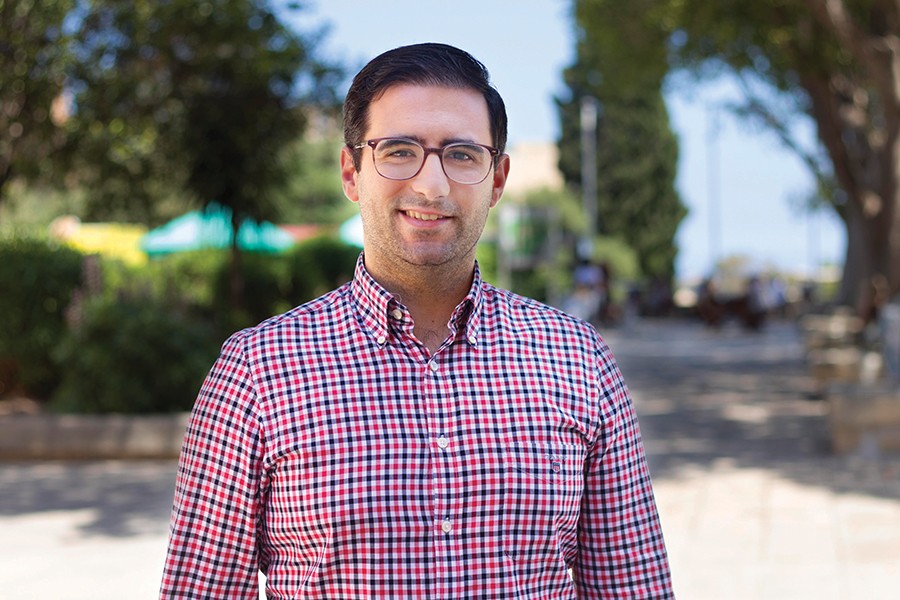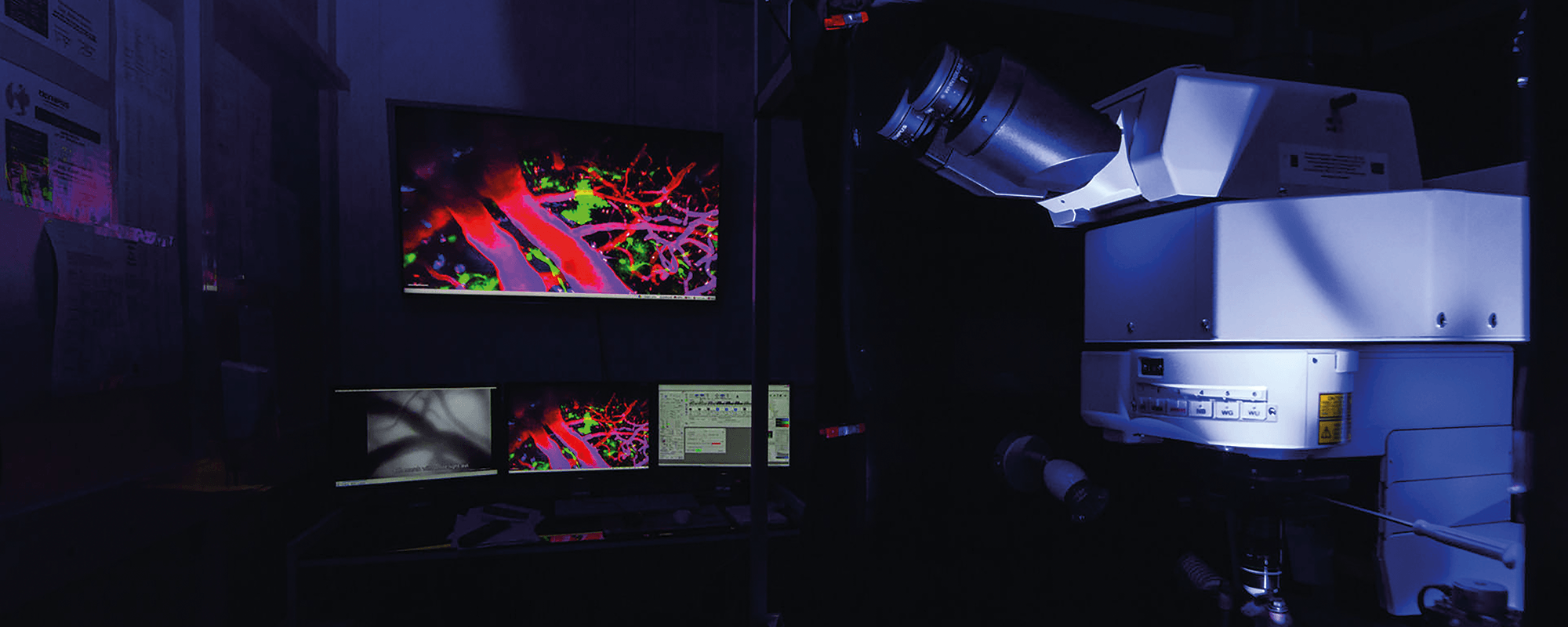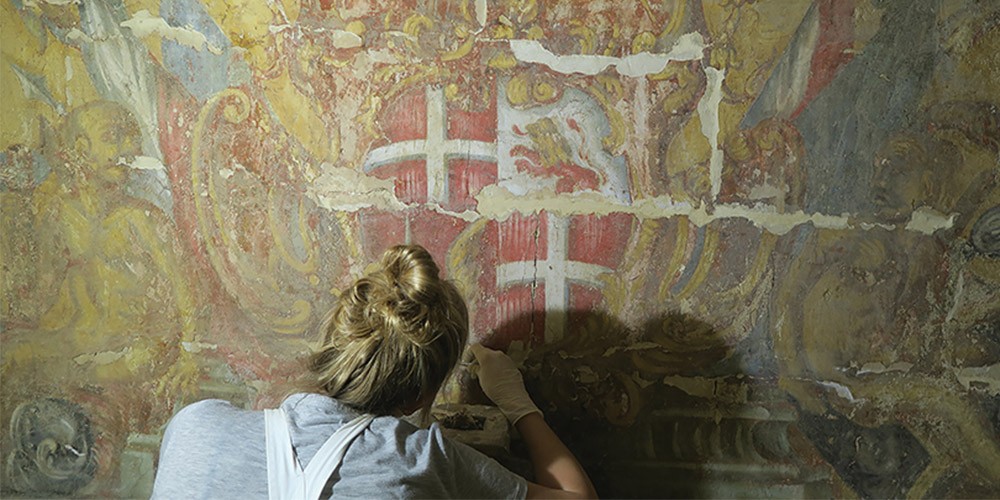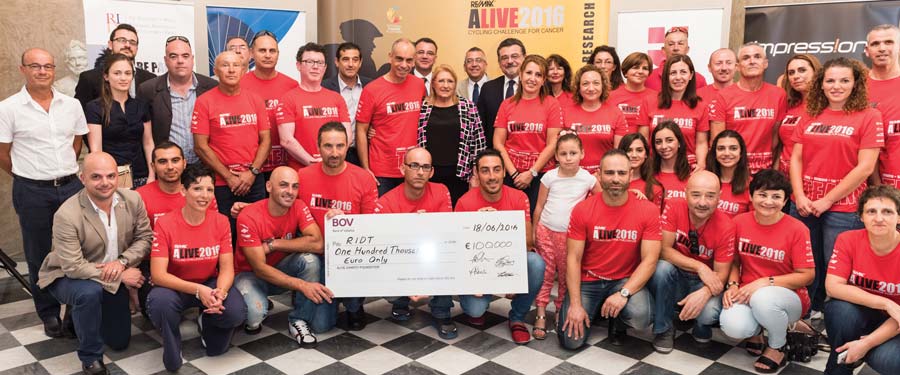A healing touch
Emerging research suggests that mild sensory stimulation like touch can protect the brain if delivered within the first two hours following a stroke. Laura Bonnici speaks with experimental stroke specialist Prof. Mario Valentino to find out how uncovering the secrets of this ‘touch’ may have life-changing implications for stroke patients worldwide.

Stroke is universally devastating. Often hitting like a bolt from the blue, it is the world’s third leading cause of death. In Malta, over 10% of the deaths recorded in 2011 were due to stroke. But stroke inflicts suffering not only through a loved one’s passing. As the most common cause of severe disability, stroke can instantly rob a person of their independence and dignity—even their very personality. This impact, individually, socially, and globally, makes stroke research a top priority.
Yet while scientists know the risk factors, signs, symptoms, and causes of both main types of stroke—whether ischemic, in which clots stop blood flow to the brain, or haemorrhagic, where blood leaks into the brain tissue from ruptured vessels—they have yet to find a concrete solution.
A dedicated team at the Faculty of Medicine (University of Malta) hopes to change that. Using highly sophisticated technology and advanced microscopic laser imaging techniques, Dr Jasmine Vella and Dr Christian Zammit, led by Prof. Mario Valentino, can follow what happens in a rodent’s brain as a stroke unfolds in real-time.
‘We use powerful lasers and very sensitive detectors coupled with special lenses, which allow us to capture the very fast events that unravel when a blood clot interrupts the blood supply in the brain,’ explains Valentino. ‘We observe what happens to the neighbouring blood vessels, nerve cells, and support cells, and the limb movements of the rodent throughout.’ Their aim is to find out how sensory stimulation might then help protect the brain.
The idea stems from an accidental discovery in 2010 by members of the Frostig Group at the University of Irvine, USA. The scientists found that when the whiskers of a rodent were stimulated within a critical time window following a stroke, its brain protected itself by permanently bypassing the blocked major artery that commonly causes stroke in humans. The brain’s cortical area is capable of extensive blood flow reorganisation when damaged, which can be brought about by sensory stimulation.
The human brain can bypass damage. For example, blind individuals have limited use of their visual cortex, so the auditory and somatosensory cortex expands, giving them heightened sensitivity to hearing and touch. For stroke patients, this means that the brain can compensate for its loss of function by boosting undamaged regions in response to light, touch, or sound stimulation.

‘This accidental discovery could be life-changing for stroke patients. The key is to figure out the mechanism involved in how sensory stimulation affects stroke patients, and then establish the best ways to activate that mechanism. Perhaps touching a stroke victim’s hands and face could have a similar beneficial effect, and this is what this latest research study hopes to define,’ says Valentino.
‘The team is now painstakingly correlating the data obtained during this brain imaging with the rodent’s movement and trajectory,’ he continues. ‘Using a motion-tracking device fitted under a sophisticated microscope, we can record the behaviour of the rodent during high-precision tactile stimulation, such as stroking their whiskers, and detect any gain of [brain] function through behavioural and locomotor readouts whilst ‘looking’ inside the brain in real-time.’
If they can prove that any protection is the direct cause of new blood vessels (or other cells) resulting from the electrical activity inspired by the sensory stimulation, then the next step would be to explore ways of redirecting these blood vessels to the affected brain area.
The team’s track record is encouraging. In collaboration with scientists from the University Peninsula Schools of Medicine and Dentistry, UK, they made another recent breakthrough that was published in Nature Communications, identifying a new drug, QNZ-46, that could protect the rodent brain following a stroke.
‘That project was about neuroprotective agents – to create a drug that will substantially block or reduce the injury, and so benefit a wider selection of patients,’ elaborates Valentino. ‘The study identified the source and activity of the neurotransmitter glutamate, which is the cause of the damage produced in stroke. This led to the discovery that QNZ-46 prevents some damage and protects against the toxic effects of the glutamate. This is potentially the first ever non-toxic drug that could prevent cell death during a stroke, and the results from this research could lead to pharmaceutical trials.’

While ongoing research in these projects has been supported through a €150,000 grant from The Alfred Mizzi Foundation through the RIDT, Valentino points out that globally-significant discoveries such as these are in constant need of support.
‘The funding of such projects is so important. This money is life-changing for people in such a predicament. Health research changes everything—our lifestyle, our quality of life, our longevity. And yet, government funding for research is still lacking. It’s only thanks to private companies and the RIDT, who realise the global potential of our work, that these projects can continue to try to change the lives of people all over the world,’ says Valentino.
And while Malta may be a small country with limited resources, the work conducted within its shores is reaching millions globally, proving that when it comes to knowledge, every contribution counts. We must continue striving for more to leave our best mark on the world.
Help us fund more projects like this, as well as research in all the faculties, by donating to RIDT.
Link: researchtrustmalta.eu/support-research/?#donations
Taking solar to sea
In a world first, a small team of engineers at the University of Malta is attempting to prove that harnessing solar power in the open sea is theoretically possible and cost-effective. Laura Bonnici speaks to Prof. Luciano Mulѐ Stagno to learn more about the ground-breaking Solaqua 2.1 project.
Renewable energy is in the spotlight. In Malta—an island that is said to enjoy an average of 300 days of sunshine per year—solar power has become mainstream, enabling the country to reach its goal of using 10% renewable energy by 2020.
But any advantage Malta has in terms of abundant sunshine, it loses through its lack of another vital resource: space. Measuring just 316 km², Malta’s limited surface area means that, beyond the existing photovoltaic (PV) panels installed on rooftops or disused quarries, any land left for larger PV installations is rare and expensive.

Prof. Luciano Mulѐ Stagno at the University of Malta believes the answer to this problem lies not on land, but at sea. Malta being surrounded by water, he has proposed that installing solar panels in open water, in offshore floating PV farms, could be as cost-effective and reliable as those on land—an idea that has never progressed beyond the theoretical stage anywhere in the world.
‘There are many PV projects happening on fresh water everywhere, from China and the UK to France and USA. But none of them are working on open sea,’ explains Mulѐ Stagno. ‘Their PV farms are installed in more sheltered, land-locked waters such as irrigation ponds or lakes, believing that PV farms cannot survive sea conditions. The Solaqua project aims to prove that they can survive, and do so at a comparable cost to land-based PV farms.’
When funding was secured from MCST in 2012, the previous Solaqua 1.0 project set about achieving these ambitious aims. Testing various prototypes out at sea, it confirmed that large, floating platforms were viable, cheap to construct, and could produce more power than similar systems on land.
The sea proved beneficial for many reasons. ‘The offshore panels produced around 3% more energy than similar land-based modules simply by being at sea, possibly due to the cooler temperatures at sea and a less dusty environment.’
The success of the first project inspired a second. With this one, the modular raft was designed and tested. ‘Solaqua 2.0 was financed by Takeoff [The University of Malta’s business incubator] in July 2017, with a preliminary design for the platform almost completed. Now discussions are underway about possible patents for the design,’ Mulѐ Stagno elaborates. ‘The ultimate aim is to launch a large farm in Maltese territorial water which, if it meets

the cost and power output targets, will be followed by other systems worldwide.’
The Professor and his team (marine structural engineer Dr Federica Strati, systems engineer Ing. Ryan Bugeja, and engineer Martin Grech) are now starting the next phase of the Solaqua project. Before the team builds and launches a full-scale system, they have to conduct a series of rigorous wave tank tests. Using a scale model while mimicking the worst possible sea conditions that the system may encounter, the team will be able to refine the design and optimise power output by testing the effect of water motion, cooling, or even different types of panels.
‘Through Solaqua 2.1, we hope to reassure investors that the system is viable. Once completed, we will be ready to launch a full-scale system that could be used not only by islands such as Malta, but also in coastal cities around the world which have insufficient land available for PV systems.’
Investors are being invited to join this project to push for global commercialisation. To reach this stage, several local entities supported the project. The Regulator for Energy and Water Services, with the help of the RIDT (the University of Malta’s Research Trust), invested €100,000 to cover the cost of constructing the scale model, as well as testing, equipment, transport, and engineers. And now that the project is commanding international interest, potential investors are being sought for the half a million euros needed to achieve a full-scale floating solar farm in Maltese waters.
‘This is a homegrown project, in which Malta could be an example to the world,’ explains Mulѐ Stagno. ‘We have already placed Malta at the cutting edge of this research area by being the first to test small systems in the open sea. Now we need to find an investor willing to take the plunge and help us create the world’s first full-scale floating solar farm. With Solaqua, Malta could be at the forefront of a ground-breaking new global industry—one which has the potential to change the way solar power is collected and used the world over.’
Conserving brushstrokes
A new conservation project will soon start work on one of Malta’s most significant historical artworks. Laura Bonnici meets Prof. JoAnn Cassar, Jennifer Porter, Dr Chiara Pasian, and Roberta De Angelis to find out why conserving the d’Aleccio Great Siege Wall Painting Cycle is of national importance.
Continue readingKidney Stakes
A small team of scientists at the University of Malta is trying to determine what causes children to be born with serious kidney defects. Laura Bonnici speaks to Prof. Alex Felice, Dr Valerie Said Conti, Esther Zammit, and Alan Curry to find out more about this ground-breaking programme.
‘I’d sell a kidney for that!’ Most of us have been guilty of using this expression when faced with something desirable. But do we fully appreciate the real value of what we are offering before the words escape our lips?
Kidneys are our body’s official waste disposal system, filtering out toxic build-up from our blood, which can poison us if left unchecked. With kidney failure posing such a threat, renal research has become an ongoing global goal.
A team of scientists from the University of Malta is currently honing in on what may cause children to be born with ‘CAKUT’, or Congenital Anomalies of the Kidney and Urinary Tract.
With between three and six cases recorded per 1000 live births worldwide, CAKUT is the most common cause of end-stage kidney disease in children. Since early identification of these anomalies may reduce kidney damage later in life, the LifeCycle Malta Foundation has raised funds for a renal research programme which targets CAKUT and its causes.
‘We know that a number of children are born with a kidney defect, but in many cases, we are not sure why,’ explains the programme’s principal investigator, Dr Valerie Said Conti . ‘There are many factors that can affect the development of the kidney, both genetic and environmental. We are trying to understand those influences so that we can carry out preventative strategies, diagnose issues earlier, and target personal therapeutic interventions.’
A number of children are born with a kidney defect, but in many cases, we are not sure why.
For this team of renal researchers, the first three years of initial research has been the first step in a far longer journey. ‘We hope to contribute our data to the international literature pool,’ continues Prof. Alex Felice, consultant and supervisor on the programme. ‘We will need a massive amount of data to create a robust theory with which to progress. We hope that our findings regarding CAKUT will be useful when we come to the stage of creating new interventions.’
It’s an end-game that has kept the small team focused as they approach the programme’s expected completion date this year. Having had to start literally from scratch, they collected biological samples from patients with a range of kidney diseases, including CAKUT, nephrotic syndrome, and Bartter syndrome. This allowed them to build the renal disease collection at the Malta BioBank, a vital storehouse for scientists.
‘For research projects like this, you see what material is available and you work with it,’ explains Said Conti . ‘A big part of it so far has been sourcing the samples from families attending the clinic with their formal consent for the material to be used in this project. We are hugely grateful to those who accepted to take part in the research. Without them, it would have been impossible.’
This project has set the groundwork for renal research in Malta to continue. ‘Without funding, projects such as this one simply could not exist,’ Said Conti remarks of the €100,000 donation LifeCycle Malta Foundation made to RIDT. ‘It enabled us to employ a full-ti me Research Support Officer, involve other laboratories, attend international meetings to share insights, perform ultrasound tests, and invest in ‘Next Generation DNA Sequencing’, genetic technology that maps out genes, revolutionising our world.’ But there is much more to come.
The Founder of the LifeCycle Malta Foundation, Personal Fitness Consultant Alan Curry, agrees. ‘Renal failure is an ever-increasing problem with figures going up every year, and LifeCycle is the only NGO that is actively supporting renal patients and their families in Malta. Our annual LifeCycle Challenge, which this year is routed from Dubai to Oman, aims to raise €150,000. It’s a huge responsibility, but we are sure that, by funding research programmes such as this, we will significantly improve the lives of kidney patients.’
Author: Laura Bonnici
Young hearts run free
For the first time in Malta, a cardiac screening programme for young people aims to identify who among them are most at risk of sudden cardiac death. Here, Laura Bonnici chats with Dr Mark Abela to learn more about the Beat It project and the impact it is having on young lives across Malta.
There are times in life when death haunts us all. It is most tragic when it strikes down our youth. This year, Italian footballer Davide Astori and Belgian cyclist Michael Goolaerts made headlines after they died unexpectedly. Also making headlines was sudden cardiac death (SCD).
Ischaemic heart disease is the most common cause of cardiac deaths, its likelihood increasing with age. A blockage in one of the arteries supplying the heart starves it of oxygen and nutrients, leading to heart attacks, sometimes resulting in cardiac arrest, in which there is sudden and unexpected loss of electrical heart function. But SCD in young people is very different from cardiac death later in life.

Much like Astori and Goolaerts, SCD victims are generally presumed to be in good health. Early symptoms are often incorrectly attributed to other issues or life changes. The result is a horrendous loss for the sufferer and their family and friends, who also have to weather biological, psychological, and social repercussions. Seeing these events unfold, specialist trainee in Cardiology Dr Mark Abela felt the time was right to offer an SCD screening programme to young people in Malta. He called the project Beat It.
The idea behind Beat It was inspired by the UK-based NGO Cardiac Risk in the Young [CRY], Abela notes. ‘CRY offers screening to young people between 14 and 35 to identify those who might be prone to heart disease. They then give follow-up advice, support, and evaluations accordingly. I realised that a similar programme would be very beneficial to young people here in Malta,’ says Abela.
In Malta, the Beat It project has focused mainly on fifth form students between the ages of 14 and 16. The cardiac screenings attempt to identify those who may be susceptible to SCD, with those prone to it referred to hospital for further tests to catch the condition before it can strike.
‘Because athletes are believed to be at a higher risk for SCD, we need to have routine screening across all sporting disciplines,’ says Abela. ‘Sport has shown the medical community that young individuals who are susceptible to genetic heart disease are still at risk of SCD. Screening helps decrease this burden. Current evidence also supports that this risk is present for non-athletic youths—so why neglect these youngsters?’
Launched officially in October 2017, the Beat It project saw nine doctors, accompanied by a team of technicians and nurses, going into schools and running screenings. Students filled in a simple questionnaire and took an Electrocardiogram (ECG) test on the spot. ‘We analysed the results in the hope of identifying heart disease in the early stages, then advised the young people if they should consider some lifestyle changes,’ says Abela. This included advice ranging from easing up on tennis, to which career choices might be most appropriate for the student based on their health. The team also advised further medical treatment and organised follow-up appointments with specialists Dr Mark Sammut, Dr Tiziana Felice, and Dr Melanie Burg in some instances. In the end, the project screened 2,700 of the 4,300 eligible fifth form students across Maltese schools, all with the support of the school administrators and teachers, who ensured that everything ran smoothly.
The significance of this project could also reach well beyond the lives of the young people themselves. ‘Since the country is so small and families are often inter-connected, genetic diseases in Malta tend to be more prominent,’ Abela emphasised. ‘The discovery of susceptibility to hereditary cardiac disease in any young person therefore also suggests that their parents or siblings may be at risk of SCD. With appropriate testing, the ripple effect of Beat It could preempt problems in entire families, maybe even saving someone’s life in the process.’
The project boosted awareness of cardiac disease and SCD for Maltese young people, their parents, and their teachers. UK data reports that eight out of 10 young deaths do not report symptoms beforehand. There is also a tendency for symptoms to be downplayed by educators who are not aware of potential problems. With this in mind, Beat It will also act as a learning platform. Since young people with cardiac abnormalities are at higher risk for exercise-related symptoms, physical education teachers are now more aware about potential red flags.
Celebrating the completion of the Beat It project, Abela expressed his gratitude for the team who made it possible. ‘The incredible dedication and teamwork of everyone involved has helped Beat It to effect positive change in young people’s lives, potentially saving some in the process.’
Note: The Beat It project is a collaboration between the Cardiology Department at Mater Dei Hospital, the Ministry of Education, the University of Malta, and the Malta Heart Foundation and is supported by corporate sponsors including Cherubino Ltd. through the Research, Innovation and Development Trust (RIDT) and TrioMed.
Author: Laura Bonnici
The Malta Community Chest Fund invests in medical research
From its very inception, the University of Malta Research Innovation and Development Trust (RIDT) aimed to catalyse a societal culture change—to see funding for research and innovation receiving broad-based and sustained support, as well as donations from large corporate donors. Indeed, a few productive years later, a silent revolution is gaining momentum as Maltese society embraces this concept.
To underline this shift, there couldn’t have been a more significant donor than the Malta Community Chest Fund (MCCF). The MCCF, under the patronage of the President of the Republic, is considered by many to be the people’s philanthropic saving pot, the national piggy bank for good causes. It raises funds through its relentless campaigning and public generosity. Following in the steps of her predecessors, the current President, H.E. Marie-Louise Coleiro Preca, has taken this endeavour to new heights with L-Istrina, the yearly telethon fundraiser which hit the €5.5 million mark in 2016.
In December 2014, following an invitation by RIDT’s CEO Wilfred Kenely, The President visited the University of Malta’s research facilities and was shown some of the world-class research projects in areas such as breast cancer, brain-computer interfacing, and kidney disorders. Following that visit, the RIDT engaged with the Office of the President to identify research projects that would be supported by the Malta Community Chest Fund.
The first project to be funded was a study in the genetics of osteoporosis. Dr Melissa Formosa (Faculty of Health Sciences) is leading this project which, having conducted studies on animal models, is looking at Maltese families with members affected with osteoporosis in a bid to to determine whether genetic factors also increase susceptibility to this bone disease.
The President’s commitment has been re-endorsed with the signing of an agreement to finance a three-year National Eye Study to the tune of €132,000. The project investigates the incidence of eye disorders such as glaucoma and cataracts across the Maltese population. To date there is no reliable data available on blindness and common eye diseases. Led by ophthalmic surgeon and visiting senior lecturer Francis Carbonaro (Faculty of Medicine and Surgery), the project will be gathering data from 1% of the Maltese population aged between 40 and 80. The goal is to determine both age and sex-specific prevalence, and the cause of blindness and visual impairment in adults.
In her message to the RIDT, the President of the Republic spoke of her ‘distinct honour and great privilege to offer the full support of the Republic of Malta to the Research Trust. My office is committed to help achieve the aspiration and values we share with the Research Trust to create sustainable economic growth as a means to social development and prosperity.’
The Malta Community Chest Fund has chosen to invest in medical research conducted within the University of Malta. In doing so, it is not only supporting the quest for research-based solutions to our daily challenges, but also sending a clear message to the Maltese community—investment in research pays.
Owning what we do
By RIDT
Thomas Huxley wrote, ‘The medieval university looked backwards; it professed to be a storehouse of old knowledge. The modern university looks forward, and is a factory of new knowledge.’ Continue reading
Leaving a legacy
A legacy gift is a planned future donation to a charity or trust which is given through a will or other designation. It allows individuals to express personal values by integrating charitable, family, and financial goals. Planned gifts drawn up in wills can be made in cash, or by donating assets such as stocks, real estate, and art pieces. The possibilities are endless.Continue reading
Giving back to the research community
Wilfred Kenely, the Research Trust (RIDT) CEO, speaks to THINK about new initiatives coming to fruition thanks a new scheme.










